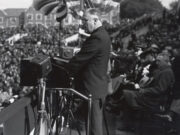In 1935 Techwood Homes became the first public housing project built in the United States. The federally subsidized housing, located immediately northwest of downtown Atlanta and sandwiched in between the Coca-Cola Company’s headquarters and the Georgia Institute of Technology’s campus, replaced a fourteen-block slum area known as Techwood Flats. Residents of the Flats lived in cheap rental housing that dated back to the 1880s, and they labored either in the nearby manufacturing and warehousing district on the west side of Atlanta or for low wages downtown. Even before the Great Depression hit, impoverished residents of the Flats endured overcrowded, unsafe, and unsanitary housing conditions.
Conception and Construction
In 1933 Atlanta real estate developer Charles F. Palmer drove through Techwood Flats on his way to work and saw conditions deteriorating. Learning of the limited dividend housing project cr eated under the administration of U.S. president Herbert Hoover, Palmer organized a group of Atlantans concerned about poor living conditions in the city. Together, believing that the federal government could give the poor of Atlanta a decent place to live, while reducing crime and disease, they wrote a proposal requesting $2,375,000 in federal funding for slum clearance and housing construction. In addition, Palmer’s buildings in downtown Atlanta represented the largest block of privately held commercial real estate in the South; improving the area would boost his property values and promote further business expansion.
Shortly after U.S. president Franklin D. Roosevelt took office in 1933, authorization for federally subsidized housing shifted to the new Public Works Administration. The Techwood project proposal won approval in October 1933. Slum clearance promised construction employment for nearly 2,000 men. The project proceeded slowly in 1934. Local landlords in particular feared unfair competition from the federal government, and federal money, caught up in bureaucratic red tape, was slow to arrive. Site acquisition and clearance took place that summer, and groundbreaking for the new Techwood Homes commenced in September 1934. Fourteen months later, President Roosevelt visited Techwood and switched on the electricity to dedicate the first public housing project.

Courtesy of Georgia Info, Digital Library of Georgia.
A Model Community
Tenants moved into the modified Georgian buildings in August 1936. The project blueprints reflected housing reform concerns for health, safety, and reasonable comfort. Local architect Flip Burge (of Burge and Stevens) designed fireproof brick buildings on concrete slab foundations. Rent included heat, electricity, and water, and the units had the latest electric appliances, as well as closets in each room. Two-story row houses and three-story garden apartments covered less than one quarter of the twenty-two-acre grounds. On the remaining property, residents enjoyed lush landscaping, playgrounds, park benches, and open space, and they had easy access to an administration building, six stores, recreational facilities, and a health clinic. Techwood Homes became a source of pride for its new residents, as well as the model studied and observed by sociologists, housing experts, and architects.
While Techwood Homes did provide affordable, clean, modern living for 604 white families, its construction also meant the clearance of the Flats, which displaced 1,611 families. Twenty-eight percent of the Flats community had been African American, and because public housing was segregated by national policy, only white residents were permitted in Techwood Homes. Some quickly found refuge in the all-Black University Homes public housing project on the west side of Atlanta, but many African Americans from the Flats were never rehoused. Furthermore, income qualifiers for public housing meant that many former Flats inhabitants, white and Black, were too poor for public housing.
Nonetheless, Techwood Homes set the standard for public housing, and its success led to congressional passage of the Housing Act of 1937, which permanently established a federally sponsored low-rent housing program.
Integration and Decline
Techwood Homes remained an all-white housing project until 1968. Racial transition occurred rapidly in the wake of the civil rights movement; the complex was 50 percent Black within six years of integration. From their nearby headquarters, Coca-Cola executives feared that crime would rise when Techwood became an all-Black project. In 1974 Paul Austin, Coca-Cola’s chief executive officer, proposed clearing Techwood, relocating its residents to the outskirts of the city, and replacing the property with moderate-income housing and shopping. Newly elected Atlanta mayor Maynard Jackson shelved the plan, fearing backlash from the African American community. Instead, Jackson garnered federal money throughout his tenure in office to renovate the Techwood structures, but this did little to stave off the drug epidemic that plagued the public housing community in the 1980s. By the early 1990s Atlanta officials were unable to combat the chronic drug trafficking and gang violence at Techwood.
Centennial Place
Ironically, the city revisited the Coca-Cola redevelopment plan for Techwood twenty-five years after it was proposed. After winning the Centennial Olympic Games bid in 1990, city leaders worried about what international guests and athletes would think about the high crime and poverty at Techwood Homes. The mayor’s office, working with the Atlanta Housing Authority, Georgia Tech, and the city’s Olympic committee, created the Olympic Village Community Redevelopment District. The plan, which called for the redevelopment of Techwood Homes into housing for athletes, converted the 1,195 units of low-income housing into 800 luxury units for mixed-income residents. Most of the original buildings were razed. Many Techwood residents, wishing to remain in their homes, felt powerless to challenge the plan.
After the 1996 Olympics ended, only seventy-eight of the original Techwood Homes residents returned to live at the newly renovated site, which was renamed Centennial Place.





